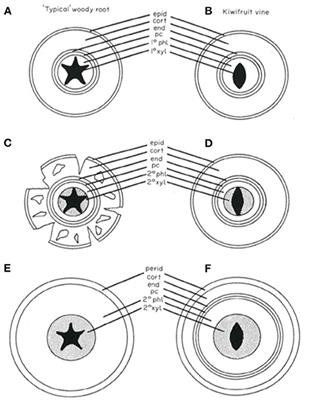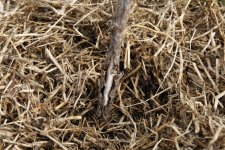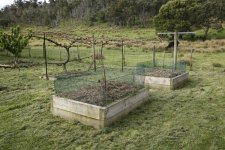I live in Launceston, Tasmania, Australia and I've been trying to grow kiwi fruit for about 12 years. Unfortunately, the following spring I find that the bark near the base of each vine has flaked off leading to a severe case of death. Out of about 20 plants I've had over the years only 3 have survived to a second summer but none have made it to a third. We get only mild frost, no colder than -4C. In the early days I went to extraordinary lengths to protect them from frosts but it didn't help. I also built raised beds for them about 8 years ago to provide better drainage and again that didn't help. With the grafted varieties it was only the bark below the graft that had flaked off, so last time I bought non-grafted plants. To my delight, they both survived their first winter without any frost protection at all. However, this spring the problem has reoccurred. In case you're thinking that the mulch might have something to do with it, that only goes on as the weather warms up. The ground is bare through winter and I keep the mulch away from the stem. The expert at my local garden center has absolutely no idea what the cause may be, so I'm stumped. I hope someone can shed some light on this problem. I really want to grow them but I might have to admit defeat on this one.
You are using an out of date browser. It may not display this or other websites correctly.
You should upgrade or use an alternative browser.
You should upgrade or use an alternative browser.
What's killing my Kiwi Fruit vines???
- Thread starter shanep
- Start date
- Joined
- Oct 8, 2017
- Messages
- 6,899
- Reaction score
- 5,070
- Location
- Birmingham, AL USA
- Hardiness Zone
- 8a
- Country

That damage is old so its hard for me, but I can do some observation. The solid nature of the peeling area is not like the rotting softness I see when I mulch too high. One side is physically missing. Where did it go? Is it in the belly of a hungry beastie?
Greetings, welcome to the Forums.
I concur, it is the only thing that makes sense. It looks like you've made some effort to guard the vines from rodents, etc. but more may be necessary. Maybe those spiral plastic tree protectors. or a layer of aluminum foil. Also traps, lots of traps.
I concur, it is the only thing that makes sense. It looks like you've made some effort to guard the vines from rodents, etc. but more may be necessary. Maybe those spiral plastic tree protectors. or a layer of aluminum foil. Also traps, lots of traps.
Thanks guys. The photo is of the male, which progressed a bit further than the female, possibly because it is smaller in diameter. The female hasn't split yet and looks normal but when you press on it there quite a bit of movement. It has certainly come away from the trunk and it's just a matter of time before it looks as bad as the male. I don't think any of the bark in the photo is missing, it's just come away from the trunk. There has never been any sign of critter damage and they do form buds and small leaves before they stop growing and start shriveling and the bark issue becomes apparent. The same thing has happened to every kiwi plant we've ever had (15-20 of them) and apparently nobody around here has ever had it happen.
Okay, alternative hypothesis generation time...
What if there is a rare fungus (or bacteria or water mold) living in your soil. This pathogen does not occur even in nearby Kiwi Vine (Actinidia deliciosa) growing areas. Kiwi vines are uniquely susceptible to the pathogenic effects of this organism. This is an unfortunate coincidence as there would be no pre-adaptation since Actinidia is not native to Tasmania.
I don't think your mild frosts would seriously injure your Kiwi Vines. If everything is actually as you interpret it, then this is a most unusual mystery. I would consider contacting the Australian agricultural department, or maybe a Kiwifruit Trade Organization. Perhaps there is a pest, disease, or cultural malady that affects Kiwi Vine in certain specific situations.
What if there is a rare fungus (or bacteria or water mold) living in your soil. This pathogen does not occur even in nearby Kiwi Vine (Actinidia deliciosa) growing areas. Kiwi vines are uniquely susceptible to the pathogenic effects of this organism. This is an unfortunate coincidence as there would be no pre-adaptation since Actinidia is not native to Tasmania.
I don't think your mild frosts would seriously injure your Kiwi Vines. If everything is actually as you interpret it, then this is a most unusual mystery. I would consider contacting the Australian agricultural department, or maybe a Kiwifruit Trade Organization. Perhaps there is a pest, disease, or cultural malady that affects Kiwi Vine in certain specific situations.
- Joined
- Oct 8, 2017
- Messages
- 6,899
- Reaction score
- 5,070
- Location
- Birmingham, AL USA
- Hardiness Zone
- 8a
- Country

Thanks guys. The photo is of the male, which progressed a bit further than the female, possibly because it is smaller in diameter. The female hasn't split yet and looks normal but when you press on it there quite a bit of movement. It has certainly come away from the trunk and it's just a matter of time before it looks as bad as the male. I don't think any of the bark in the photo is missing, it's just come away from the trunk. There has never been any sign of critter damage and they do form buds and small leaves before they stop growing and start shriveling and the bark issue becomes apparent. The same thing has happened to every kiwi plant we've ever had (15-20 of them) and apparently nobody around here has ever had it happen.
So I had to get curious. There is a kiwi decline.

Early Kiwifruit Decline: A Soil-Borne Disease Syndrome or a Climate Change Effect on Plant–Soil Relations?
Early kiwifruit decline is a physiological disorder reported for the first time in New Zealand following a cyclone that caused a heavy and prolonged flooding of kiwifruit orchards. Following studies on kiwifruit vine physiology and anatomy demonstrated that this plant has a significant water...
Inasmuch as the article spends some useful time describing the native origins of the plant and its genesis in what amounts to exceptionally high drainage settings with consistent higher humidity it is worth the struggle to read. It seems to be waterlogging and the plants cannot recover. Nobody is saying virus, but the plants dying of this and that are dying because they were weakened and the causes get considered in a opportunistic light. The article certainly describes the picture you offered with the shrunken "steele" core.
Personally I would try them in something as rash as a gritty mix. Something one might grow a plant that needs exceptional drainage in like the soil for orchids or even cacti. Time to get out of the box so to speak. It appears once they lose oxygen all kinds of trouble sets in. Thus I would attempt at extreme airspace.
The article goes so far as to mention an anerobic bacteria. But it too is then described as something tagging along with the waterloggied conditions.
I found the most relevant information to be the early description of the growing conditions first found, steep hillsides for example. Flowing streams (oxygenation) and so forth, but not the tops of mountains. It will be these conditions you would try to replicate.
Bacteri and fungus can be seen, in relatively common 400x microscopes or the lesions. But a virus is so small electron microscopes are warranted and the targets have to be pretty well vetted or one wonders about in innerspace fruitlessly. I hope its not an unknown virus. The article does speak of a sudden appearance.
The conditions that set up the splitting and separation of the merisytem from the pith in their sequence are described in the article. I guess its shrinking to split as it dessicates. Lots of vessel damage basically, in some layers, resulting in trouble for the others when growing conditions return. Bring a dictionary.
Last edited:
That article is a good find, though the symptoms sound somewhat different that what Shane is describing... but who knows.
The article used a mysterious phrase: "soil trunking and convexing". I think that might mean planting on mounds ...
Here is a basic general news report about the situation in Italy.
https://www.theguardian.com/world/2...ng-italys-kiwi-fruit-trees-baffles-scientists
The article used a mysterious phrase: "soil trunking and convexing". I think that might mean planting on mounds ...
Here is a basic general news report about the situation in Italy.
https://www.theguardian.com/world/2...ng-italys-kiwi-fruit-trees-baffles-scientists
- Joined
- Oct 8, 2017
- Messages
- 6,899
- Reaction score
- 5,070
- Location
- Birmingham, AL USA
- Hardiness Zone
- 8a
- Country

So here it is not uncommon to see lightweight white cloth over rows of tomato and other plants in the deep summer. Since water is such a great absorber of infra-red light at certain frequencies, and the plants not only are full of water but actually reflect infra-red generally, I wonder if a shade cloth might be some help. I think something that has learned to reflect infrared is saying "hey! i do not like this!".That article is a good find, though the symptoms sound somewhat different that what Shane is describing... but who knows.
The article used a mysterious phrase: "soil trunking and convexing". I think that might mean planting on mounds ...
Here is a basic general news report about the situation in Italy.
https://www.theguardian.com/world/2...ng-italys-kiwi-fruit-trees-baffles-scientists
The plant temps would be altered a great deal. I dislike the narrow description of ambient temps when used for high range effects because solar radiation is not mentioned and certainly can spike actual surface temps much higher, easily 30 - 35f higher here. Dependant on hours of cloud cover those heating hours can produce a great amount of heat energy.
I would think plants grown in greenhouses that control temps via translucent rather than transparent panels would show success, and that might be an indicator it is not from an outside biological actor of some sort.
Last edited:
Wow, you guys are amazing. You've really done your homework! I think you might be on the right track with the Early Kiwifruit Decline theory. I hadn't heard of it before now, but it does make sense if there is something persistent in the soil. For the first few years I was growing them in the same spot but at ground level and waterlogging would have been an issue, leading me to build the raised beds.
I haven't yet been able to find a list of specific symptoms associated with it, so I don't know if the flaking bark is one of them.
I'll take Marck's advice and try to contact government agriculture departments and commercial grower organisations and see if they can help. Thanks again.
I haven't yet been able to find a list of specific symptoms associated with it, so I don't know if the flaking bark is one of them.
I'll take Marck's advice and try to contact government agriculture departments and commercial grower organisations and see if they can help. Thanks again.
- Joined
- Oct 8, 2017
- Messages
- 6,899
- Reaction score
- 5,070
- Location
- Birmingham, AL USA
- Hardiness Zone
- 8a
- Country

Good luck with it all. Maybe they are already working on hybrids or grafting to different root stock. Certainly tricks that have come about for lesser reasons.
The description of your stem issue is touched on here, but its written in a foreign language so I admit to forcing myself to read it through though I could not quote the last sentence:9
"Structural roots show a brown discoloration of the stele, fibrous roots show cortical decay, and the cortical tissue loses rigidity and detaches from central stele (Reid et al., 1991; Tosi et al., 2015)."
Stele is defined below. The author used a variety of words across the work for the same or nearly similiar part and so displaces the readership that they get lost. Perhaps grant money is afoot. Who knows?
Stele:
Botany-
the central core of the stem and root of a vascular plant, consisting of the vascular tissue (xylem and phloem) and associated supporting tissue.
The description of your stem issue is touched on here, but its written in a foreign language so I admit to forcing myself to read it through though I could not quote the last sentence:9
"Structural roots show a brown discoloration of the stele, fibrous roots show cortical decay, and the cortical tissue loses rigidity and detaches from central stele (Reid et al., 1991; Tosi et al., 2015)."
Stele is defined below. The author used a variety of words across the work for the same or nearly similiar part and so displaces the readership that they get lost. Perhaps grant money is afoot. Who knows?
Stele:
Botany-
the central core of the stem and root of a vascular plant, consisting of the vascular tissue (xylem and phloem) and associated supporting tissue.
Last edited:
Ask a Question
Want to reply to this thread or ask your own question?
You'll need to choose a username for the site, which only take a couple of moments. After that, you can post your question and our members will help you out.
Similar Threads
Forum statistics
Latest Threads
-
Marigolds
- Started by big rockpile
-
How to properly save seed from a strawberry to cold stratify and sow
- Started by texc16195
-
Fruit and vegetables seeds
- Started by Danielnoble01
-
Happy Saint George's Day
- Started by zigs
-
Noob at growing lettuce, 1 is dying, dunno why
- Started by 2jjg4
-
Indeterminate Cheapness of Tomatos?
- Started by gunslingor
-
Summer Crops
- Started by Sas02
-
Mushrooms
- Started by Esther Knapicius
-
Old Westbury Garden Pine Tree identification
- Started by CLIVIAJOHN



